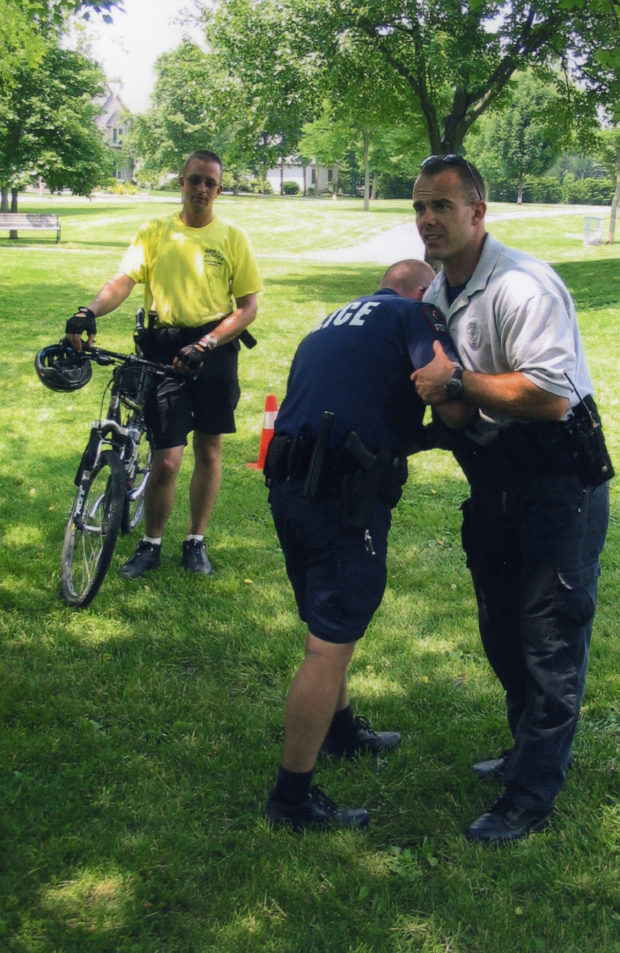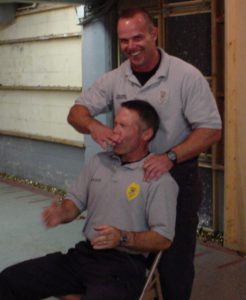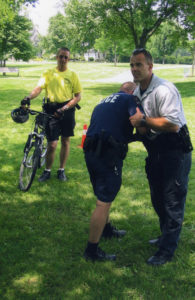Written by: Greg Ellifritz
Although much of the population views the police officer as proficient in all aspects of unarmed self-defense, practical experience proves otherwise. Conversations with police officers will usually show that most officers receive little, if any, unarmed self-defense or defensive tactics training after their initial course of instruction in a basic police academy. I believe that the study of police defensive tactics has not been given the priority it deserves and propose to remedy this by taking a closer look at the frequency and type of defensive tactics training suburban police officers receive.
The goal of the study was to quantify how much training suburban police officers receive in the field of defensive tactics. This field includes all aspects of hand-to-hand combat, unarmed self-defense tactics, and suspect control methods. For the purpose of this study I did not include training in the areas of firearms, impact weapons, electronic devices, or chemical sprays. After determining how much defensive tactics training officers receive, I wanted to determine if officers feel confident in their abilities and, if not, how much training they think they should receive in order to improve their proficiency. I also looked at what factors prevented agencies from providing more training and what factors prevented officers from pursuing additional training on their own time. Finally I solicited opinions from officers as to the best methods for improving defensive tactics training in their agencies.
I chose a population of suburban police officers for this study because I believe that these agencies have the greatest ability to improve their training as a result of this research. Suburban agencies are generally wealthy enough to provide the resources necessary to create an effective defensive tactics program and are generally large enough to provide in-house training. Smaller agencies occasionally lack the budgets, staff, and facilities to provide adequate in-house training. Larger agencies may be limited in what they can provide due to the sheer numbers of officers that must be trained every year.
I chose six central-Ohio agencies on which to base our research. I purposely chose those six for two reasons. The first is that they represent a good cross section of suburban agencies throughout the county as a whole. The agencies range in size from eighteen to seventy officers and cover a wide geographic area containing populations with differing demographic characteristics. The second is that I had at least one reliable personal contact employed in each agency. This contact was able to ensure that the surveys were properly distributed and encourage officers within the agency to complete it.
Instrument and Methodology
Once the agencies were identified, I wrote a letter to each chief explaining the purposes of the research and requesting permission to survey their officers. Once the chiefs granted permission, I distributed the surveys to our designated contacts in each agency. The contacts passed out the surveys to all sworn officers and gathered the completed surveys after two weeks’ time.
The surveys were six pages in length and asked twenty-four separate questions. There was also considerable space for the officers to express additional comments or concerns. The questions were broken down into three distinct sections. The first section gathered personal information for comparison purposes and evaluated the officers’ attitudes towards training. The second section evaluated the officers’ confidence levels and quantified the amounts of defensive tactics training that their agencies provided. This section also allowed officers to share what types of administrative concerns effected the amount and quantity of their training. The final section quantified the amount of training officers undertook on their own time as well as asking them for reasons that they did or did not choose to engage in such training.
The surveys took approximately ten minute to complete. Surveyed officers were insured anonymity. Furthermore, I assured the officers that I would not compare individual agencies to each other nor would I discuss which agencies were included in the final results section of the research.
RESULTS
A total of 266 surveys were distributed. I received 110 responses. This forty-one percent response rate is a fairly high for the type of survey that I constructed. It has been the authors’ experiences that people in general, and police officers in particular, are unlikely to take the time to complete a survey of this magnitude unless they have a compelling personal interest in the topic. I believe that the encouragement our contacts provided contributed to the relatively high response rate. Of the total respondents, seventy-nine were officers, eighteen were sergeants, two were lieutenants, and two were chiefs. Nine did not report their ranks.
Ninety-five respondents were male and fourteen were female. Seventy-nine officers were assigned to patrol duties, sixteen were detectives, six were DARE/school resource officers, three were assigned to training, and three held other assignments. Three officers did not report their job descriptions. Nearly fifty-two percent of the officers responding stated that they had been involved in a situation while working where they wished they had better defensive tactics training.
Overall, officers reported receiving a mean of 6.78 hours of defensive tactics training last year. If sorted by rank I found that the officer rank received 7.29 hours of training while the sergeants received 4.39 hours of defensive tactics training. There was no significant difference between amounts of training and assignment (detective, DARE, etc.).
When asked the question “How many hours per year of defensive tactics training do you believe agencies should provide their officer to insure officer proficiency in the defensive tactics shill area”, the mean response was 28.71 hours per year. The officer-ranked respondents had a higher mean (29.72 hours) than their sergeants (20.67 hours). Not enough administrative staff (Lieutenant rank or above) returned the survey to draw any conclusions about their views.
There were many reasons officers believed that their respective administrations did not provide them with adequate amounts of training. I broke these reasons into two categories, opportunity cost issues (cost of training, training time devoted to other topics, overtime and scheduling issues) and issues that do not involve opportunity costs. Within the opportunity cost category, the most common response from both administrators and officers to the question “which of these cost issues do you think affects the amount of training you receive?” was the issue of overtime and scheduling. More than eighty-five percent of respondents claimed this as a concern.
A second question ranked the perceived impact of all non-cost issues on the amount of defensive tactics training received. The primary non-cost related reason officers believed they did not receive enough training was “No legal requirement from OPOTC for mandatory training”. OPOTC is the Ohio Peace Officer Training Commission. This organization sets all training standards for Ohio police officers. Currently there is no mandated in-service training requirement in the area of defensive tactics for police officers.All of ranked factors are listed below (in order of perceived importance):
1. No legal requirement for in-service training
2. Lack of knowledge of the need for defensive tactics training
3. Personnel injury complaints
4. Lack of interest from officers
5. Lack of adequate facilities
6. Lack of qualified instructors
When comparing the above rankings, I noted that the primary reason (no legal requirement) was ranked more than twice as important as the number six ranking of lack of qualified instructors. Interestingly, when sorted for rank, these rankings remain exactly the same between officers and supervisors (including sergeants, lieutenants, and chiefs).
Approximately thirteen percent of the respondents stated that they engaged in defensive tactics or martial arts training outside of work. This training is conducted while the officer is not in a “duty” status and is paid for by the officer, not the department. Not surprisingly, officers who reported enjoying training the most were the most likely to train while off-duty.
There was no significant reported difference between the sexes with regard to percentage of officers engaging in defensive tactics training on their own. The reason officers supplied for not training while off-duty are as follows:
Lack of time: 86.1%
Expense: 76.9%
Lack of interest: 45.4%
Don’t believe I should attend work-related training if my employer does not provide it: 42.6%
Don’t consider it necessary: 31.5%
Fear of injury: 20.4%
Not enough knowledge to choose a good class: 20.4%
No training facilities near my residence: 16.7%
Not physically fit enough to participate in classes: 12%
After obtaining the above information, I then asked officers what factors would make them more likely to start an off-duty defensive tactics training program. Their ranked responses follow:
If agency provided time off for training: 58.3%
If they could find a short-term class: 53.7%
Inexpensive classes: 45.4%
Police-only class: 38.9%
Classes taught by experienced police officers: 33.3%
Given the officers’ responses, it seems that a lack of time is the most important factor governing why officers do not engage in defensive tactics training on their own.
Despite the fact that the majority of respondents stated that they wished they had better defensive tactics training at some time in the past, and that officers report needing far more training than they currently receive, officers’ confidence in their abilities was extraordinarily high. On a scale rating the officers’ reported levels of confidence in their defensive tactics skills from one (little confidence) to five (very confident), the mean was 3.71. Patrol officers were slightly more confident than detectives. DARE and SRO personnel had the same confidence levels as the patrol officers. There was also no significant difference in confidence levels between male and female officers.
The impact of officer confidence cannot be overstated. Although there is limited academic research in the area of police confidence and performance, there are some studies that have correlated increased self confidence with increased performance.
– Stress-based training in the area of defensive tactics has been shown to improve confidence, reduce anxiety, and enhance performance.
– Police Officers who express confidence in the courtroom are more likely to be believed by jurors.
– Police Self Confidence and Motivation can be improved by training
My study showed a positive correlation between confidence and amount of training officers received last year and the amount of defensive tactics training that officers engaged in while off duty. Both correlations were statistically significant. This means that the more training an officer receives, either provided by the department or conducted in an off-duty capacity, the more confident an officer will be.
CONCLUSIONS AND RECOMMENDATIONS
Officers need more training in defensive tactics than they are currently receiving. They state that they require more than four times the amount of their current training in order to become proficient. Officers think that they need more training than their supervisors think they do. Additional training will benefit officers and departments by increasing officer confidence levels.
When the officers were asked what their agencies could do to improve defensive tactics training, one suggestion was offered more than any other. Forty-eight percent of officers who answered the question stated that their department should offer more frequent training. Most of these suggestions also said the duration of the training could be shorter as long as the training was conducted with more regular frequency. Many other officers suggested implementing short courses of instruction in roll calls when officers are on their shifts. This seems like a win-win solution. Officers receive more training as measured by both frequency and amount, while administrators will not have to deal with scheduling concerns or overtime costs. Officers reported that for the most part they are confident in the instructors that the department already has. If these instructors were deployed strategically on every shift, weekly roll call training sessions could be held at no cost to the agency.
Agencies should also consider providing some type of additional time off for officers who take defensive tactics training while off-duty. Perhaps a small amount of comp time could be provided to each officer depending on the amount of time he or she spends in off-duty defensive tactics training. Agencies might also consider paying for approved off-duty defensive tactics training for officers. Some officers suggested that existing plans that allow for tuition reimbursement for higher education be expanded to cover this type of training.
I also recommend that agencies consider pooling their training resources. Most agencies teach similar defensive tactics programs. Departments often have “empty seats” in some training sessions due to scheduling difficulties, injuries, and unplanned court appearances. Trading these “empty seats” with other agencies would result in a way to improve the total amount of training each officer receives at no additional cost. This also reduces overtime and scheduling difficulties because training opportunities will be more abundant.




